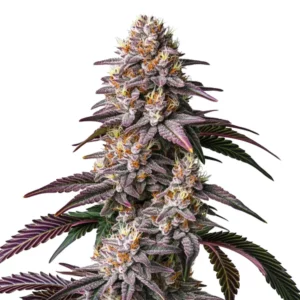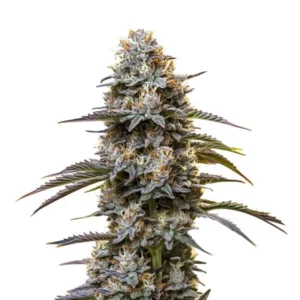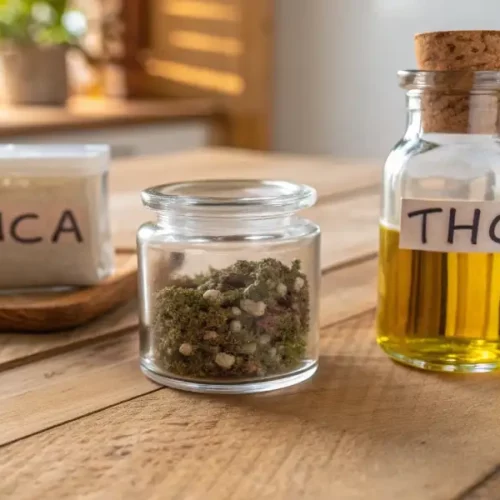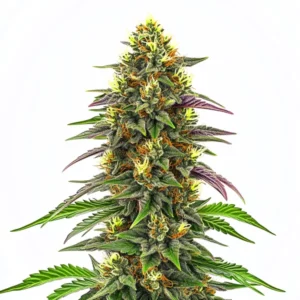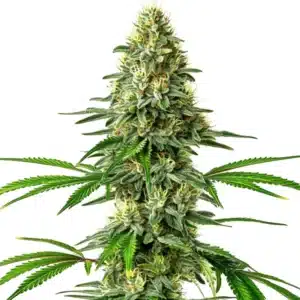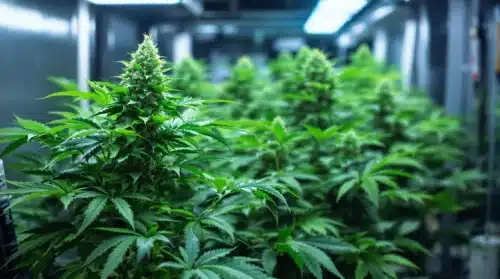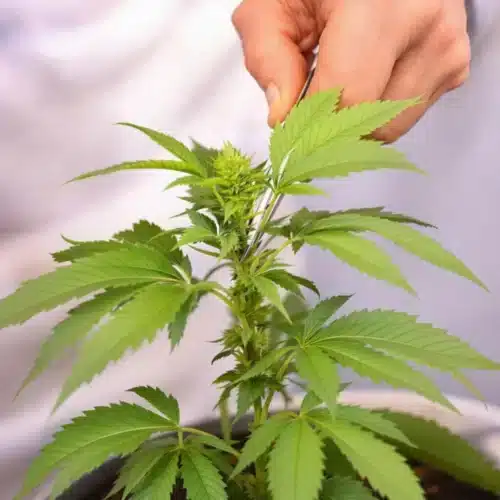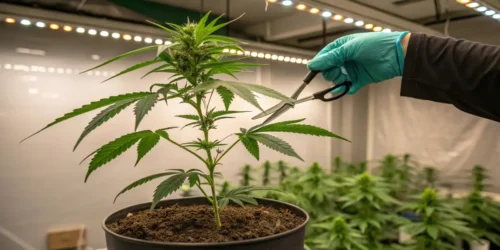Autoflowering cannabis strains have gained popularity among cultivators for their ease of growth and rapid lifecycle. Defoliation, the practice of strategically removing leaves from a plant, can significantly influence the health and yield of these autoflowers. This guide dives deep into the nuances of defoliating autoflowers, offering insights and instructions for enthusiasts and experts alike.
Introduction to Autoflowering Cannabis
Autoflowering cannabis strains have rapidly emerged as a favorite among growers for their unique characteristics, which significantly differ from traditional photoperiod strains. Unlike their photoperiod counterparts that require specific light cycles to flower, autoflowers transition from the vegetative stage to the flowering stage with age, making them an ideal choice for beginners and those seeking a quick turnaround. This remarkable trait stems from the introduction of genetics from Cannabis ruderalis, a subspecies known for its autoflowering ability, into the more commonly known Cannabis sativa and Cannabis indica strains.
The beauty of autoflowering cannabis lies in its simplicity and efficiency. These plants typically require less maintenance, and their compact size makes them perfect for discreet cultivation, both indoors and outdoors. However, the reduced vegetative phase means that every decision in their care has a heightened impact, including the practice of defoliating auto.
Defoliating autoflowers is a technique employed by cultivators to improve light penetration and airflow within the plant canopy. This method involves carefully removing select leaves to ensure that lower buds receive adequate light and air, promoting healthier growth and potentially leading to an increased yield. While defoliation is widely practiced among photoperiod cannabis growers, it demands a nuanced approach when applied to autoflowers due to their rapid growth cycle and smaller size.
The choice to defoliate autoflowers requires thorough knowledge of the plant’s growth stages and the specific traits of autoflowering strains. Timing is key; improper defoliation can stress the plant and slow its progress. Therefore, growers must carefully weigh the benefits of defoliation against the natural growth patterns of autoflowers to ensure that this technique boosts, rather than diminishes, the plant’s potential.
In essence, autoflowering cannabis offers a world of opportunities for cultivators looking to maximize their grow space and achieve quick harvests. The addition of defoliating techniques to the care regimen of autoflowers, when done correctly, can further optimize the growing process, leading to robust plants that are both healthy and high-yielding. As we delve deeper into the specifics of defoliating autoflowers during flowering, it’s essential to approach this practice with caution and knowledge, ensuring that each plant can thrive under the grower’s careful watch.
Promos & Deals
The Science Behind Defoliation
Defoliating autoflowers, a method often surrounded by debate among cannabis cultivators, stands as a pivotal technique aimed at enhancing plant health and boosting yield. This practice, when executed correctly, can significantly influence the growth dynamics of autoflowering cannabis strains. The science behind defoliation and incorporating the keyword “Defoliating Autoflowers” into our exploration, we can demystify the process and its effects on these unique plants.
At its core, defoliation involves the strategic removal of leaves from a plant. The primary goal is to improve light penetration and airflow within the canopy. Autoflowering cannabis plants, known for their compact size and rapid growth cycle, can particularly benefit from this technique. Defoliating autoflowers helps ensure that light reaches the lower branches, which in turn can increase the energy available for bud development.
Moreover, the process of defoliating autoflowers can stimulate the plant to redistribute its resources. By removing select leaves, the plant is encouraged to focus its energy on the development of flowers rather than sustaining unnecessary foliage. This redirection of resources can lead to more robust bud production, a key objective for most cultivators.
However, the science behind defoliation also highlights the importance of timing and moderation. Autoflowers have a predetermined lifecycle, which means that stress recovery time is limited. The strategic timing of defoliation is crucial to avoid hindering the plant’s growth. Typically, the best periods for defoliating autoflowers are during the late vegetative stage and early flowering phase, when the plant can recover quickly without compromising its developmental timeline.
Tthe balance between risk and reward is essential in the practice of defoliating autoflowers. While the benefits include improved light exposure and potentially higher yields, there is also the risk of stress-induced stunting if the process is not carried out with care. Therefore, cultivators must weigh the potential gains against the risks, ensuring that defoliation aligns with the specific needs and growth patterns of their autoflowering cannabis plants.
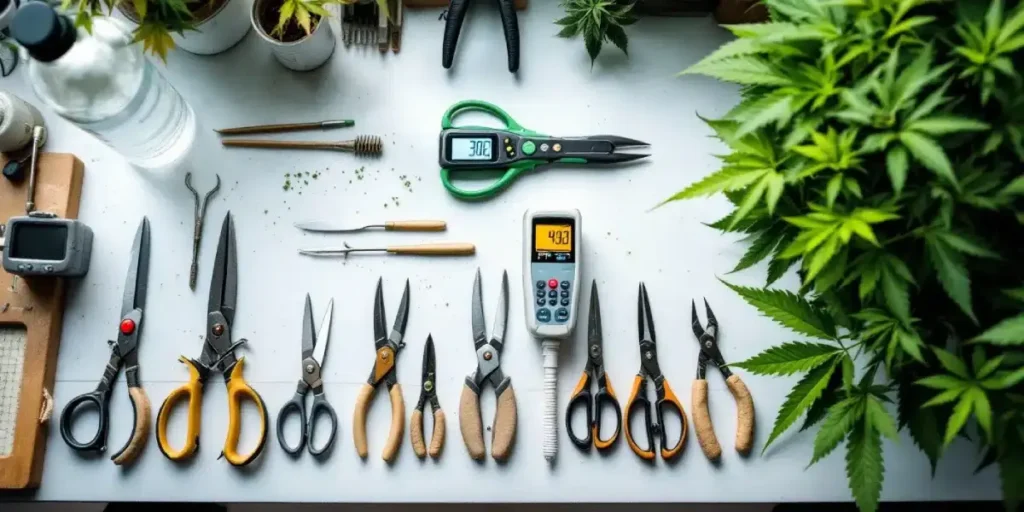
Timing is Everything in Defoliating Autoflowers
When it comes to defoliating autoflowers, timing isn’t just a factor, it’s the cornerstone of success. The unique growth cycle of autoflowering cannabis is crucial before you begin the defoliation process. Autoflowers transition from the vegetative stage to the flowering stage automatically, unlike photoperiod strains that require changes in light exposure. This automatic transition means the window for effective defoliation is narrower and requires precise execution.
Identifying the Optimal Time for Defoliation
The optimal timing for defoliating autoflowers is when the plant is in the late vegetative stage or early flowering stage. This timing is critical because it allows the plant to recover and direct more energy towards bud production. However, it’s essential to avoid defoliating too late into the flowering stage, as it can stress the plant and potentially reduce yield.
During the late vegetative stage, autoflowers start to show signs of their upcoming flowering phase. This period is ideal for defoliation because the plant is still focusing on leaf and stem growth, and removing some leaves can encourage more light penetration and airflow to lower parts of the plant. This increased light and air can lead to stronger, healthier growth and potentially more bud sites.
Growth Stages and Defoliation Timing
- Seedling Stage: At this early stage, defoliation is not recommended. Autoflowers are rapidly developing their root systems and initial leaves, and any form of stress can be detrimental to their growth.
- Early Vegetative Stage: As autoflowers transition into vegetative growth, they begin to develop a more robust leaf structure. While light pruning might be tempting, it’s often best to wait until the plant has established a solid foundation of leaves and stems.
- Late Vegetative Stage: This is the prime time for your first major defoliation. The plant is strong enough to handle the stress of losing some leaves and can benefit significantly from the increased light penetration and airflow.
- Early Flowering Stage: If you didn’t defoliate in the late vegetative stage, early flowering offers a last chance to do so without stressing the plant too much. Focus on removing only the most necessary leaves to avoid over-stressing your autoflowers.
Defoliating Autoflowers at the correct time not only enhances the plant’s overall health and yield but also minimizes the risk of mold and pests, which can thrive in dense, poorly ventilated foliage. By mastering the timing of defoliation, you can ensure your autoflowers have the best possible environment for growth and productivity. Remember, each plant is an individual, and observing your plants closely will provide the best indicators for when they’re ready for defoliation.
How to Defoliate Autoflowers
Defoliating autoflowers is a nuanced technique that, when done correctly, can significantly enhance the health and yield of your cannabis plants. This process involves the careful removal of certain leaves to improve light penetration and air circulation within the plant’s canopy. Here, we delve into a detailed guide on how to master defoliating autoflowers, ensuring you can implement this practice with confidence and precision.
Tools and Preparation
Before you begin the process of defoliating autoflowers, it’s crucial to gather the right tools. You will need a pair of sharp, sterilized pruning shears or scissors. The cleanliness of your tools cannot be overstated; dirty tools can introduce pathogens to your plants, leading to potential health issues. Also, prepare a disinfectant solution to clean your tools before and after use, minimizing the risk of disease spread.
Step-by-Step Defoliation Process
- Assessment: The first step in defoliating autoflowers is to assess your plant thoroughly. Look for leaves that are shading buds sites, dead or dying foliage, and any leaves that are touching the soil, as these can attract pests or develop mold.
- Strategic Removal: Begin with the lower canopy, removing leaves that receive little to no light. These are usually the first to show signs of nutrient deficiency and are the least productive. Then, move to the inner canopy and remove leaves that are blocking light to budding sites. The goal is to open up the plant structure, allowing light to penetrate and air to circulate more freely.
- Gentle Approach: It’s crucial to be gentle and deliberate in your approach to defoliating autoflowers. Remove leaves sparingly, focusing on those that clearly impede light or airflow. It’s recommended to defoliate over several days or weeks, rather than all at once, to reduce stress on the plant.
- Timing: The timing of defoliation is critical. The optimal time for defoliating autoflowers is just before the light period, allowing the plant to recover during its ‘daytime’. Avoid defoliating during the flowering stage, as this can stress the plant and potentially reduce your yield.
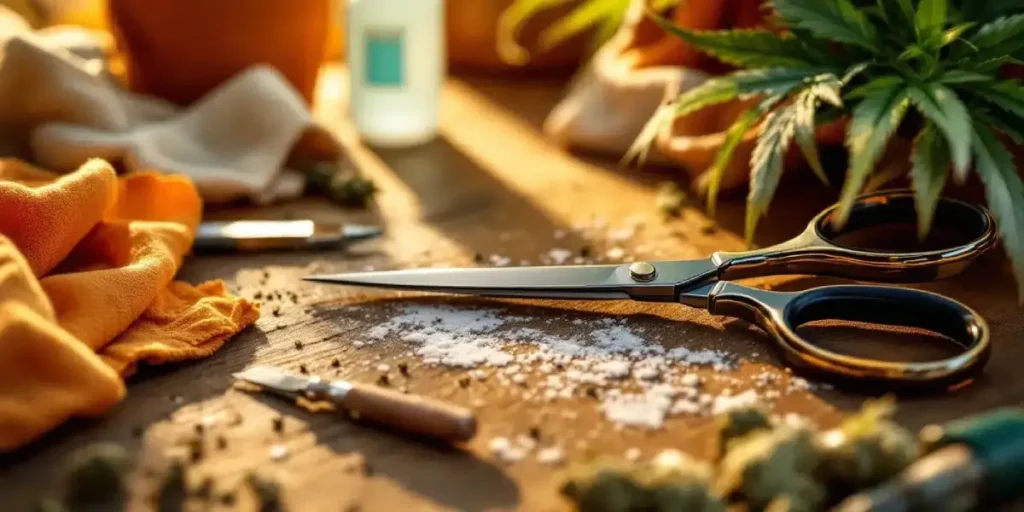
Post-Defoliation Care
After defoliating autoflowers, it’s essential to monitor your plants closely. Ensure they have adequate water, but be cautious of overwatering, as the reduced foliage means the plant will use water more slowly. Adjust your nutrient feed if necessary, as the plant’s nutrient requirements may change slightly after defoliation.
Monitoring and Adjusting
Keep a close eye on your autoflowers in the days and weeks following defoliation. You should notice improved light penetration and air circulation, leading to healthier growth and development. If you observe signs of stress, such as drooping leaves or stunted growth, review your defoliation technique and make adjustments as necessary.
Advanced Techniques and Tips for Defoliating Autoflowers
Defoliating autoflowering cannabis plants can significantly impact their health and yield. However, to harness the full benefits of this practice, one must approach it with a blend of art and science. This section delves into advanced techniques and tips that can help cultivators fine-tune their defoliation strategy, ensuring the best outcomes for their autoflowering cannabis plants.
Strategic Leaf Removal for Optimal Light Penetration
One of the primary objectives of defoliation is to improve light penetration and airflow within the plant canopy. For autoflowers, which typically have a shorter vegetative phase, strategic leaf removal is crucial. Remove leaves that are:
- Overshadowing bud sites, preventing them from receiving adequate light.
- Yellowing or showing signs of damage, as they’re unlikely to contribute positively to the plant’s growth.
- Directly competing with each other for light, especially if they’re large and located on the upper part of the plant.
Lollipopping: Sculpting the Lower Canopy
Lollipopping involves stripping away most or all of the growth on the lower third of the plant. This technique redirects the plant’s energy towards the upper, more productive branches. Autoflowers, with their compact size, benefit greatly from lollipopping as it reduces the risk of moisture-related issues and improves air circulation around the base.
Stress Management Techniques
Defoliation is a stress-inducing practice, and autoflowers, due to their ruderalis genetics, are particularly sensitive to stress. Implement stress management techniques such as:
- Gradual defoliation: Instead of removing a large number of leaves at once, spread out the process over several days.
- Adequate hydration and nutrition: Ensure the plant is well-watered and fed, particularly with a balanced mix of nutrients that supports recovery.
- Optimal environmental conditions: Maintain a stable environment with appropriate temperature, humidity, and light levels to help the plant recover more efficiently.
Selective Defoliation Based on Plant Structure
Not all autoflowers grow the same. Some may develop a dense canopy, while others remain sparse. Adjust your defoliation strategy based on the individual plant’s structure. In denser plants, more aggressive defoliation might be necessary to ensure light reaches the lower bud sites. Conversely, sparser plants may require minimal intervention.
Timing Revisited: The Subtle Signs
Beyond the obvious growth stages, pay attention to subtle signs that indicate a plant’s readiness for defoliation:
- Turgor pressure: A plant with leaves that are firm and upright is in a better state to handle the stress of defoliation.
- New growth patterns: Plants about to enter a vigorous growth phase are more likely to recover quickly from leaf removal.
The Final Touch: Post-Defoliation Care
After defoliation, it’s essential to monitor your plants closely. Adjust your watering schedule, as the plant’s transpiration rate might decrease, reducing its water needs. Additionally, consider a mild foliar feed with a seaweed-based solution to provide essential micronutrients that aid in stress recovery.
By mastering these advanced techniques and tips, cultivators can enhance the efficiency of defoliation, promoting robust growth and increased yields in autoflowering cannabis plants. Remember, each plant is unique, and adopting a tailored approach will yield the best results.
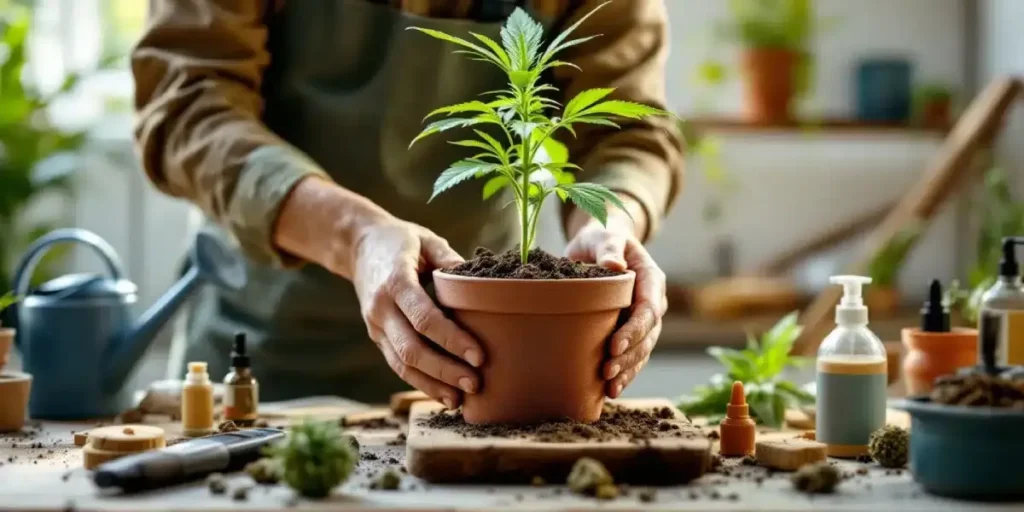
Common Mistakes to Avoid
When cultivating autoflowering cannabis, the margin for error can be slim due to their fast life cycle and unique growth requirements. Defoliation, while beneficial when executed correctly, can lead to significant setbacks if not approached with care. Here are some common mistakes to avoid when defoliating autoflowers, ensuring your plants remain healthy and productive throughout their lifecycle.
Overdefoliation and Its Consequences
One of the most common errors is overdefoliation. Autoflowers, due to their compact size and rapid growth cycle, can be particularly sensitive to stress. Removing too many leaves in a single session or throughout the plant’s life can hinder rather than help your crop. Leaves are not just expendable parts of the plant; they are essential for photosynthesis, the process through which plants convert light into energy. Without sufficient foliage, your plant cannot produce the energy needed for growth and bud development, leading to stunted plants and reduced yields.
To avoid overdefoliation:
- Never remove more than 20-30% of the foliage in one session.
- Focus on removing only the leaves that are blocking light to budding sites or causing airflow issues.
- Allow your plant to recover for at least a week before considering additional defoliation.
Ignoring Plant Signals
Another mistake is ignoring the signals your plant gives you. Plants communicate their health and stress levels through their leaves, stems, and overall stature. For example, leaves that droop or yellow can indicate overwatering, nutrient deficiencies, or stress. Proceeding with defoliation without addressing these underlying issues can exacerbate the plant’s stress and potentially lead to its demise.
To stay attuned to your plant’s needs:
- Regularly check your plants for signs of stress or disease.
- Address any issues you identify before carrying out defoliation.
- Remember that a healthy plant will recover from defoliation much more effectively than a stressed one.
Improper Timing
Timing is crucial when it comes to defoliating autoflowers. Doing it too early or too late in the plant’s life cycle can have adverse effects. Defoliating too early, especially before the plant has established a strong root system and sufficient foliage, can stunt its growth. On the other hand, defoliating too late, especially during the flowering stage, can stress the plant and divert energy from bud development to healing and regrowth.
To optimize the timing of defoliation:
- Avoid defoliation in the first few weeks of the plant’s life until it has at least 3-4 true leaf nodes.
- The best time for a significant defoliation is just before the flowering stage, as this can improve light penetration and air circulation around the buds.
- Perform any necessary minor touch-ups early in the flowering stage, but avoid significant defoliation once buds begin forming.
Using Incorrect Tools or Techniques
The tools and techniques used for defoliation can also impact the plant’s health and recovery. Using dull scissors or tearing leaves can create jagged wounds that are more susceptible to infection and stress.
To ensure a clean and stress-free defoliation:
- Always use sharp, sterilized scissors or pruning shears.
- Make clean cuts at the base of the stem to minimize damage and facilitate quick healing.
- Sterilize your tools before and after use to prevent the spread of pathogens.
Neglecting Post-Defoliation Care
After defoliation, plants require special attention to recover and continue growing vigorously. Neglecting post-defoliation care, such as proper watering, feeding, and monitoring for stress, can limit the benefits of defoliation and put your plants at risk.
To support your plants after defoliation:
- Monitor your plants closely for signs of stress and adjust your care routine accordingly.
- Ensure your plants have adequate water and nutrients to support recovery and growth.
- Consider slightly increasing humidity to reduce transpiration stress while the plant recovers.
Avoiding these common mistakes can dramatically improve your autoflower defoliation results, leading to healthier plants and more bountiful harvests. Remember, the goal of defoliation is to support the plant’s growth and development, not to challenge its survival.

FAQs
Is it safe to defoliate autoflowering cannabis plants?
Yes, it is safe to defoliate autoflowering cannabis plants if done correctly and at the right time. The best window is during the late vegetative or early flowering stage. Removing too many leaves or defoliating during the wrong stage can stress the plant and reduce yield, so timing and technique are crucial.
What are the benefits of defoliating autoflowers?
Defoliating autoflowers improves light penetration and airflow within the plant canopy. This can enhance bud development, reduce the risk of mold and pests, and lead to higher yields. Additionally, it helps the plant redirect energy from unnecessary foliage to essential flower sites.
How do I know when to defoliate my autoflower plant?
The optimal time to defoliate autoflowers is in the late vegetative stage or early flowering stage, when the plant is strong enough to handle leaf removal. Avoid defoliating during the seedling phase or late flowering, as this can cause stress and negatively affect bud growth. Look for signs like dense foliage shading bud sites or poor airflow as indicators.


